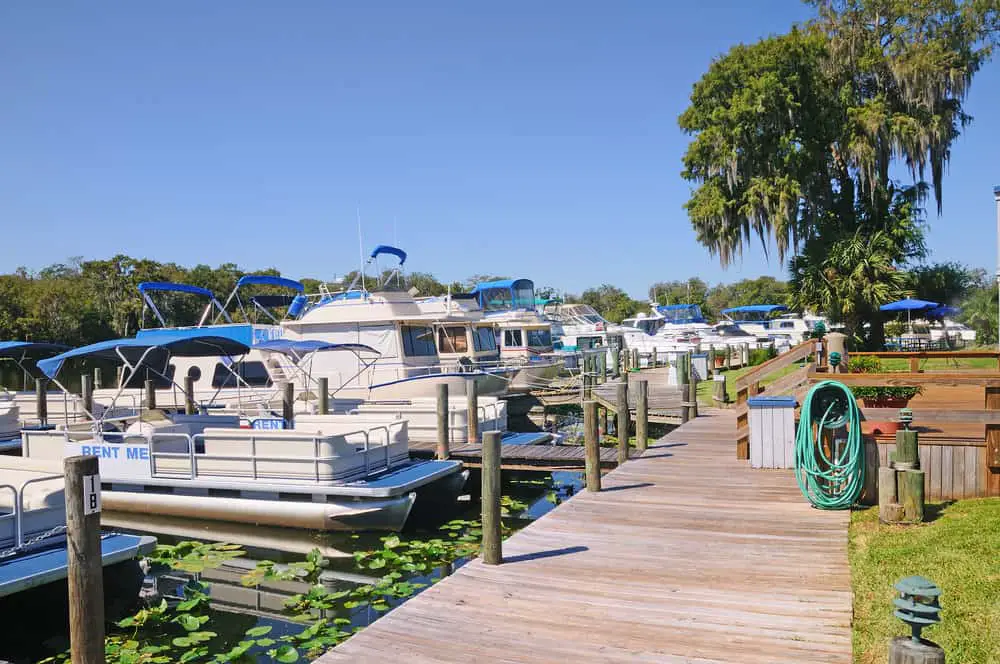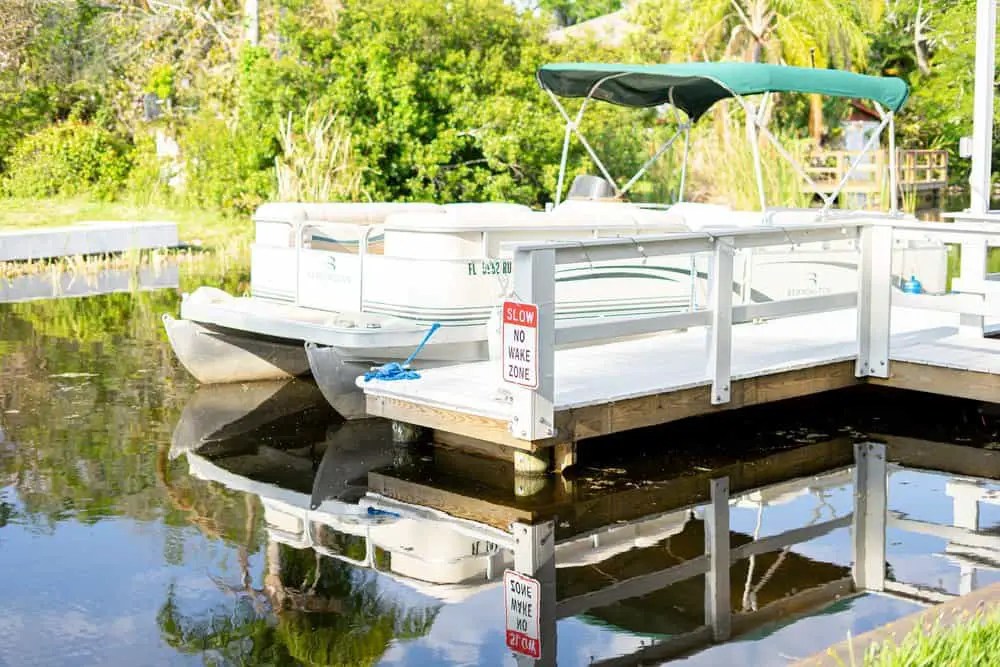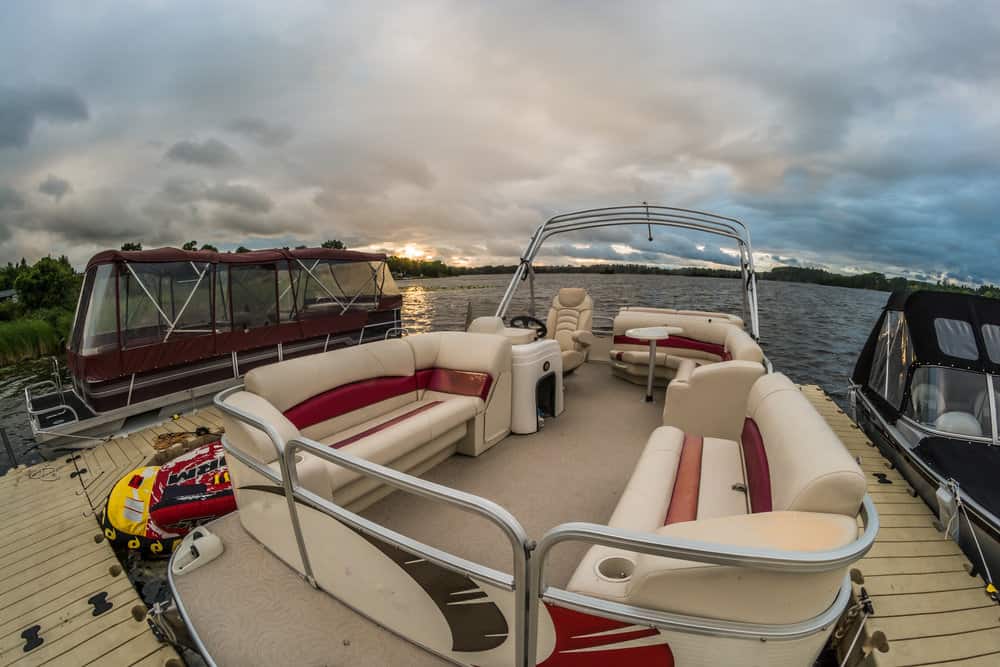Pontoon boats are notorious for being different in terms of handling compared to standard (monohull) boats. This extends to their handling when docking, and some individuals are frightened at the task.
In fact, it is a pretty straightforward task to dock a pontoon boat. What factors are involved? How fast should you go? Must you come in at an angle? All these questions and more are answered in this article, including precisely how to dock your pontoon boat and how to dock it in a slip.
How To Dock A Pontoon Boat
Pontoon boats are generally more difficult to dock (park) than monohull boats due to them being vulnerable to the wind (which we will discuss).
It will help if you remember that trying to dock a boat can at times be difficult because, unlike a car where when you hit the brakes, it stops, a boat will drift (coast). Even a slight wind can throw you off course, and the last thing you want is to slam into the dock damaging it or your pontoon.
We will now cover how to dock a pontoon boat but consider that there are factors regarding the process that you should read over after the tutorial. This will help you understand the why and how of docking your pontoon boat.
Step 1. Approach The No-Wake Zone And Take Out Your Bumpers
The first thing you need to consider is the distance to the no-wake buoys. You will want to stop your pontoon boat at a suitable space away from the no-wake buoys and make sure that you have taken out any necessary bumpers and ropes. It is also suitable to proceed with this step as you are casually drifting through the no-wake zone.
Take note that approximately two or three large bumpers(fenders) will suffice. Also, make sure that your bumpers (fenders) are appropriately spaced out and placed on the side of the boat relative to the side of the dock you wish to pull into.
At this point, you may even open the doors on your boat, allowing you to have easy access to the dock as you approach. Additionally, if your pontoon boat has a front door, having it open will allow you to set up and adjust your angle because you have more visibility of the dock. This is because you will want to set up the angle of your pontoon using its center alignment.
Step 2. Approach The Dock Slowly And At An Angle
The main factor to consider is to dock your pontoon boat slowly, and you never want to leave the boat in motion. This means you never want to leave the throttle up. You effectively want to bump the throttle as you get closer and are pulling into the dock (essentially giving the boat throttle and then removing it).
By doing this, you will be able to adjust your again slightly as you go, also making sure that you are not coming in too fast. Heading into the dock you would try to aim for an angle of about 30 degrees.
Step 3. Compensate For Control By Adjusting The Throttle
Once you have this angle, you will aim straight for a spot on the dock and nudge the boat towards this spot with your throttle. Remember that your pontoon is in neutral at this point, and you are only slightly bumping the throttle to make minor adjustments to your direction and to have a degree of control.
It is important to note that you are able to coast towards the dock at this point, but if you do, your ability to steer will be minimal. This is because the effect of the rudder will be marginalized due to there being no discharge current from the propeller. To help you achieve more control, you will only need to remember to bump the throttle up on occasion.
This is a bit of a catch-22 situation ( mutually conflicting dependent conditions) because the problem is the best way to turn your pontoon is with power. However, to minimize skidding and to execute a sharp turn using low power is preferred. This is why it is vital to understand that controlling and nudging your throttle is key.
Step 4. Turn Your Steering Wheel Towards The Dock
Keep in mind that now your pontoon should be headed relatively worry-free towards the dock (Newton’s first law of motion). As you edge closer and closer to the dock, you will need to decide at what point you will need to turn towards the dock. This includes how long and how sharp of a turn you will have to make. Remember that not all docks are the same size, and due to this, you will need to use logic and compensate with steering.
However, it is likely that you will be pulling into the same dock more often than not. Thus judging the moment you have to turn will get more proficient the more experience you get (the more times you dock).
At this point, you should be close to the dock and now what you will do is turn the steering wheel towards the side of the dock you are aiming to dock on. Then you will put the pontoon in reverse. The pontoon will automatically start to swing its rear end towards the dock by doing this.
Step 5. Turn Your Steering Wheel Away From The Dock
When you are about 10 feet out, you will swing the steering wheel in the opposite direction to the dock. This will allow the pontoons nose to start to move away from the dock, essentially aligning your pontoon parallel up to the dock.
Your pontoon should be almost ready to dock at this point. However, once you get close enough to the dock, you will want to turn the steering wheel all the way towards the side of the dock. You will then give the pontoon throttle a slight bump in reverse, and that will swing the boat’s rear end toward the dock.
Step 6. Dock Your Pontoon Boat
Your pontoon boat should now, at this point, be aligned and situated next to or close to the dock. For additional measures, you can ask one of your crew or passengers (preferably one who has secured a boat to a dock cleat before) to help you at the bow of the boat in order to soften the docking. They will do this by grabbing the dock, the dock cleat, or another person on the dock.
If you do not have a person to help you with this, then just pull the boat into the dock slowly (as we recommended). If done correctly, you should be able to swing the boat and get close enough so that you are able to jump off yourself.
If you intend to dock the boat yourself, you will jump off and grab the centerline of the boat and gently pull it towards that dock.
How To Dock A Pontoon Boat In A Slip

Docking a pontoon in a slip will be a bit more challenging. However, the same rules as we mentioned before will still apply. Hence, without repeating ourselves, consider the steps of the previous section and account for changes.
Step 1. Change Your Angle Of Approach
You will only need to consider that your angle of approach will not be so aggressive. Additionally, you will still want to place your bumpers on the side of the boat that is facing the side of the dock you are heading towards. If the slip is big enough, and you are able to put bumpers on either side of the boat, then it would be preferable to do so.
Step 2. Do Not Face The Dock Head-On
Take note that you don’t ever want to try and dock into a slip head-on because the current, a wave, or the wind may knock you off course. By coming in at an angle, you will have a degree of control, and this will be compounded by the fact that you are nudging the throttle.
Step 3. Turn The Steering Wheel Toward The Dock
When you have approached the dock and are about 10 feet out, you will turn the steering wheel into the dock. This will allow the pontoon to align its nose straight up with the slip.
Step 4. Straighten Out Your Steering Wheel
Once you are sure that the pontoon is aligned straight up with the slip, you will straighten out your steering wheel. This is because you will now guide the pontoon into the slip using the throttle, and having the wheel turned at this point will adjust the angle (which you do not want).
Take note that as you are maneuvering the pontoon at an angle towards the slip and when you are inching it forward, you will be putting it into reverse to slow the boat down if need be.
Step 5. Dock Your Pontoon Boat
Then you will simply nudge the throttle to move the pontoon forward into the slip. Remember that slips are typically very tight in terms of their space, so jumping off and securing it to the dock should not be a problem once the pontoon is in.
Factors To Consider When Docking Your Pontoon Boat
Now that you know how to anchor your pontoon both on a regular dock and a slip, here are some factors you should consider. These elements will help you understand how to dock your pontoon better, giving you some insight on gaining a little more experience without actually having to practice.
Learning To Dock A Pontoon Boat With Experience
A pontoon boat is a somewhat different driving experience from a regular boat (monohull boat), and due to its nature, you may be tempted not to take it out in windy conditions.
However, watching videos and reading articles on how to dock a pontoon boat (like this one) is all good and well, but the only way to improve is to practice it and gain experience.
Moreover, because it is so vastly different from docking and driving other boats, you may want to consider taking a couple of lessons with a professional until you are certain you feel comfortable behind the wheel.
How To Dock A Pontoon Boat Regarding Speed And Momentum

Consider that with regards to a pontoon boat that, momentum does not equate to speed. An ideal docking situation is where you should find the correct amount of energy that will help you overcome currents and strong winds (if any) while not accelerating towards the dock.
Aligning your boat and shifting into reverse is the key here (which we will discuss later). The pontoon will naturally sway when docking due to the currents and wind. This is because you will have to adjust numerous times accordingly to anchor by stopping and starting. Thus you will lose momentum. This means you should do this as quickly as possible and be wary of your surroundings.
Docking Your Pontoon Boat With The Wind And Current
The preferable situation for any docking scenario is that you would want to dock inline with the wind and current (if this is at all possible), or at least inline with one of these.
Thus, if you are going against the wind while reversing into position, it may be your while trying to circle around and trying to approach in the opposite direction.
More often than not, you will find docking much easier this way instead of trying to struggle against the current or winds. Even though you may think it’s a waste of time, it could effectively actually save you time. Using the wind or current to your advantage will simply allow you to drift and glide seamlessly into position rather than struggling every inch of the way.
Docking Your Pontoon Boat With A Line
Depending on how severe the weather conditions are, you may find docking your pontoon to be too much of a challenge. Also, in some situations where your experience in docking is limited, you may want to ask a member of your crew or someone on the dock to help you draw it in with a line.
Although this may seem impractical, in some situations having your pontoon pulled in can save you a headache and a ton of grief.
Common Problems With Docking A Pontoon Boat
Some would say that a pontoon boat is somewhat ironically, easily, and more difficult to handle around a dock.
Take into consideration that a pontoon boat is very susceptible to wind (as we stated). This is largely due to its shape and size. Remember that a pontoon boat is primarily a flatboat that relies on floats enabling it to remain buoyant. Thus, You may find yourself being thrown off course if there is a heavy crosswind.
Conversely, it is also harder to make drift in and out of parallel parking when trying to dock along a shore wall. Hence, sometimes its benefits can be its drawbacks.
Conclusion
We discovered that docking a pontoon boat is not that complicated, but there are some factors to consider when doing so. The main factors to remember are that you should take it slow, not go against the wind or current, come in at an angle, and you should control momentum and speed by nudging the throttle.
If done correctly, there will be no need for any extra assistance, and you should be able to dock a pontoon boat with relative ease.
Project “Get Her In Straight” Boating
Check out our article on: How To Beach A Boat: (Two Must Know Techniques!)

